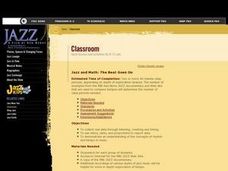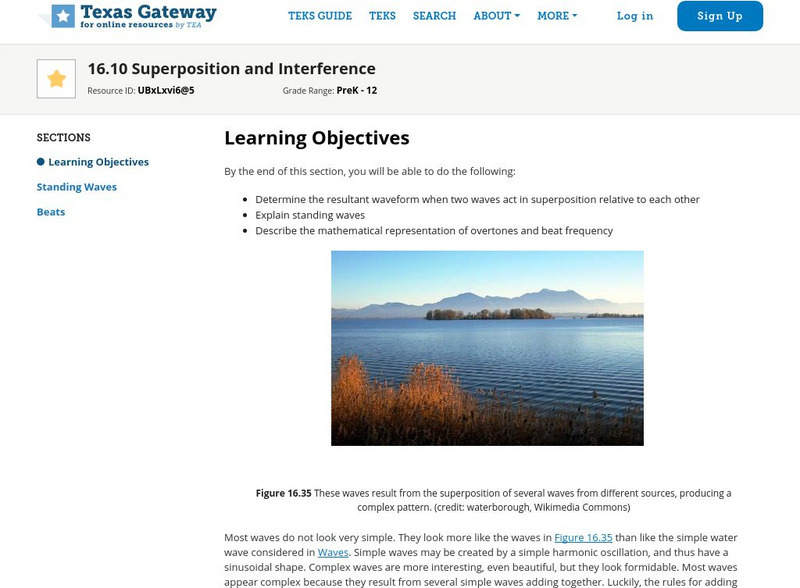Curated OER
Theater Arts/Creative Movement Lesson Plan
Here is a series of five exercises intended to bring movement, dance, and theater into the classroom. Intended for special ed classes, but appropriate for any grade, learners will pantomime, play pretend, dance, move, and create...
Curated OER
Finding Your Pulse Rate
Fifth graders demonstrate how to find their pulse and count the beats after a certain amount of time. In cooperative pairs, 5th graders use a stopwatch to keep track of their partner's heart rate in seconds. Pairs make a graph from their...
Curated OER
Beat the Beat!
Students develop a sense of pulse by listening to music with strong beats. In this music beats lesson, students listen to marching band music examples. Students then practice showing the beat while listening to the song.
Curated OER
Musical Rhythm and Pulse
For this music worksheet, students examine the use of rhythm and pulse in musical pieces. They practice clapping beats that include rests in the given rhythm boxes. They compose their own beat in a rhythm box.
Curated OER
Dynamics
Third graders recognize and identify the three types of balance. They analyze and identify the type of balance used in various works of art. Students create a symmetrically balanced work of art. They use a ruler, shape templates, an...
Curated OER
Jazz and Math: The Beat Goes On
Students collect real data through listening, counting and timing jazz pieces.They use ratios, rates, and proportions to report collected data and demonstrate an understanding of the concepts of rhythm and tempo in music.
Curated OER
3-5: Rhythm Beginnings
Students explore tempo. In this rhythm beginnings lesson plan, students differentiate between steady and unsteady beats. Students clap a variety of tempo and then move to the tempo of a song.
Curated OER
Illustration # 1: Source of Illustration
Students play a game of imitating steady beats by mimicking the instructor. They use drums and repeat the game by echoing rhythmic patterns. The patterns may vary in degree of difficulty according to each individual's ability.
Curated OER
Form, Rhythm, and Melodic Motives: Fiber
Students examine basic song form and 4/4 meter. They sing a song about diet and nutrition while identifying examining the rhythm of the song. They discuss why fruit and fiber are important to health.
Curated OER
Music
Third graders incorporate two formal music lessons into the core curriculum. They study whole notes and rests, syllables of the musical scale and practice singing.
Curated OER
Follow The Leader - Soca Style
Students participate in a fun and creative experience in dance. This is a great activity for warm-ups, the end of class, all-school assemblies and family nights!
PBS
Pbs Learning Media: An Egyptian Clock
The CyberSquad must construct a clock of sorts in order to keep track of the amount of time they have to rescue Dr. Marbles in this video segment from Cyberchase.
PBS
Pbs Learning Media: A World Tour of Clocks
In this video segment from Cyberchase, learn about the workings of a variety of timekeepers.
Other
Basic Music Theory: Bar or Measure
This website is extremely valuable in that it describes topics in easy-to-understand language. Relatively easy to follow. Just use the hypertext links.
Music Theory
Music theory.net: Odd Meter
This site gives a brief definition of an odd meter. Use the arrows at the bottom to navigate. Provides illustrations and a printable chart.
Texas Education Agency
Texas Gateway: Superposition and Interference
By the end of this section, you will be able to determine the resultant waveform when two waves act in superposition relative to each other, explain standing waves, and describe the mathematical representation of overtones and beat...
Georgia State University
Georgia State University: Hyper Physics: Interference of Sound
Information about the interference of sound and its causes. Well-illustrated and good explanations of the concepts; part of a large hyper-textbook on various physics concepts.
Science Buddies
Science Buddies: Beats
Systematically explore different frequency combinations in this experiment provided by Science Buddies. You will use your computer to create sound files to play pure tones on your computer, one frequency in the left channel, and another...
OpenStax
Open Stax: Catherine Schmidt Jones: Pitch Sharp, Flat and Natural Notes
Learn about the meanings and uses of pitch and accidentals. Including sharp, flat, natural and double sharps and flats, this lesson explains why they are necessary.
OpenStax
Open Stax: Catherine Schmidt Jones: Fractions, Multiples, Beats, and Measures
Engage your students in a lesson that uses music to identify multiples and fractions. Your students will enjoy participating in this activity as they learn and explore music and math.
Walter Fendt
Walter Fendt: Apps Zur Physik
This site, in German, offers numerous apps that illustrate common physics principles. Apps are organized into categories: mechanics, oscillations and waves, electrodynamics, optics, thermodynamics, the theory of relativity, physics of...




















